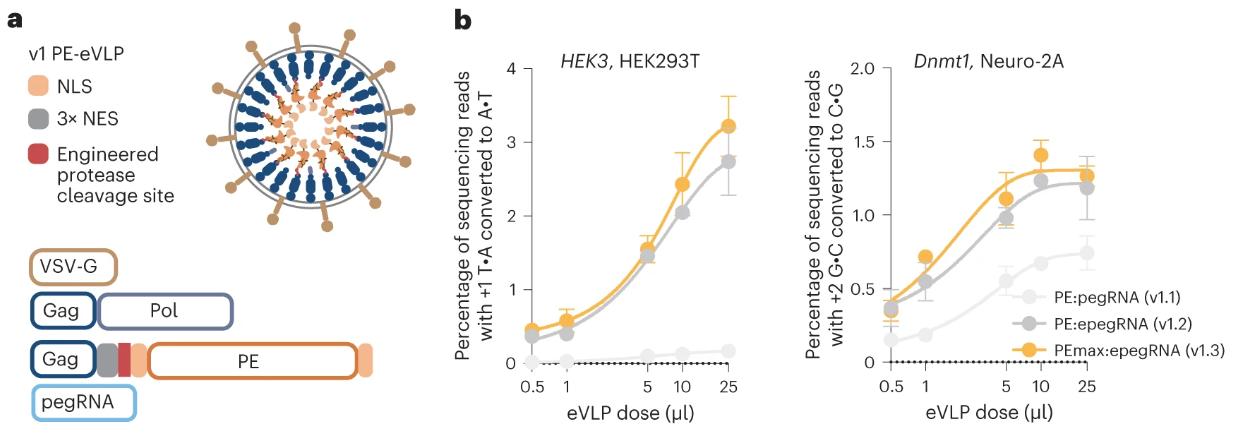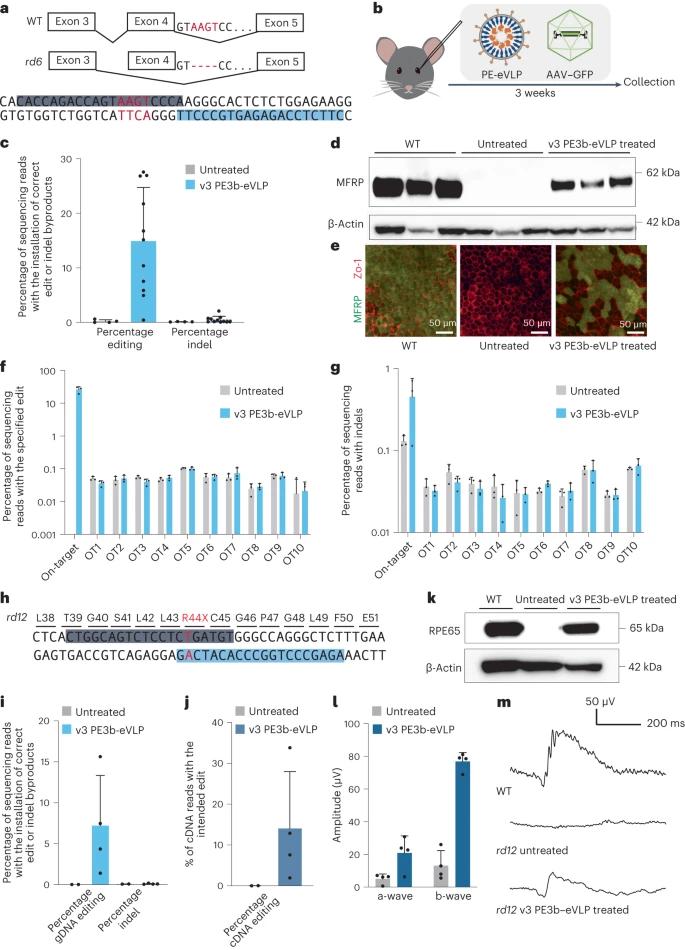David Liu's team from the Broad Institute in the United States published a research paper titled "Engineered virus-like particles for transient delivery of prime editor ribonucleoprotein complexes in vivo" in the journal Nature Biotechnology. This study developed prime editor engineered virus-like particles (PE-eVLPs) that deliver prime editor proteins, prime editing guide RNAs and nicking single guide RNAs as transient ribonucleoprotein complexes. The researchers systematically engineered v3 and v3b PE-eVLPs with 65- to 170-fold higher editing efficiency in human cells compared to PE-eVLP constructs based on previously reported base editor eVLP architectures. And achieved in vivo base editing and restored partial visual function in two mouse models of genetic blindness.
The PE-eVLP system optimized in this study supports transient in vivo delivery of prime editor ribonucleoproteins, can also reduce off-target editing, avoid potential carcinogenesis caused by gene integration, and enhances the safety of prime editing.
"It is generally believed in the gene editing field that future gene editing mechanisms should ultimately be delivered in the form of proteins to minimize potential side effects, and this study demonstrates an effective approach." Professor Liu Ruqian said, "The lab is continuing to actively work on improving eVLPs and adapting the delivery vehicle to target other tissues in the body."
In January 2022, Liu Ruqian's team published a paper in the journal Cell and developed an engineered virus-like particles (eVLP), which can overcome multiple bottlenecks in gene editor delivery and successfully deliver a base editor and achieve efficient gene editing in mice.
Therefore, eVLP can be used as a potential therapeutic macromolecule delivery vector, which combines the key advantages of viral and non-viral delivery vectors and can deliver gene editing tools to cells and in vivo organs to achieve efficient gene editing. It has the lowest off-target effects and is very safe. As a candidate vector for in vivo prime editor (PE) delivery, eVLPs have several significant advantages over other delivery vehicles:
(1) eVLP is not subject to strict delivery size restrictions, so there is no need to split the prime editor for delivery.
(2) eVLP can directly package and deliver gene editors in the form of ribonucleoprotein (RNP), thereby performing instantaneous gene editing, which can effectively reduce the frequency of off-target editing.
(3) eVLP is completely formed by protein self-assembly and does not contain DNA, which avoids the risk of unnecessary viral genetic material being integrated into the host cell genome.
(4) eVLPs can be pseudovirally modified through different glycoproteins to achieve specific targeting of organs or cells.
| Cat.No. | Product Name | Price |
|---|---|---|
| VLP-0001 | Chikungunya Virus-Like Particle | Inquiry |
| VLP-0002 | Dengue Virus-Like Particle (Serotype 1) | Inquiry |
| VLP-0003 | Dengue Virus-Like Particle (Serotype 2) | Inquiry |
| VLP-0004 | Dengue Virus-Like Particle (Serotype 3) | Inquiry |
| VLP-0005 | Dengue Virus-Like Particle (Serotype 4) | Inquiry |
| VLP-0007 | Ebola Virus-Like Particle | Inquiry |
| VLP-0008 | Japanese Encephalitis Virus-Like Particle | Inquiry |
| VLP-0009 | Mayaro Virus-Like Particle | Inquiry |
| VLP-0010 | Norovirus-Like Particle (GI.1) | Inquiry |
| VLP-0011 | Norovirus-Like Particle (GII.4) | Inquiry |
| VLP-0012 | O'nyong'nyong Virus-Like Particle | Inquiry |
| VLP-0013 | Parvovirus VP2 Virus-Like Particle | Inquiry |
| VLP-0014 | Rubella Virus-Like Particle | Inquiry |
| VLP-0015 | Zika Virus-Like Particle | Inquiry |
| VLP-0016 | Wild Type SARS-CoV-2 Virus-Like Particle | Inquiry |
In this latest work, Liu Ruqian's team developed an engineered virus-like system for delivering prime edits - PE-eVLP. PE-eVLP can deliver the complete prime editing system in the form of ribonucleoprotein (RNP) in vivo. In the engineered virus-like system BE-eVLP for delivering base editing, which was previously developed by Liu Ruqian's team, the base editor (BE) was simply replaced by the prime editor (PE).

Figure 1. a, Schematic of v1 PE-eVLPs. b, Prime editing efficiencies of v1 PE-eVLPs. (An M, et al., 2024)
By systematically identifying PE-eVLP delivery bottlenecks and designing corresponding solutions, the research team developed the third generation v3 PE-eVLP. Compared with v1 PE-eVLP, its prime editing efficiency in mouse brain neuroma cells (Neuro-2A cells) increased 79-fold and the editing efficiency in human HEK293T cells increased 170-fold.
Next, the research team conducted in vivo experiments in mice. A single subretinal injection of v3 PE-eVLP enables efficient prime editing in mice. Correcting the 4bp deletion of the Mfrp gene in the rd6 retinitis pigmentosa mouse model and replacing the Rpe65 gene mutation in the rd12 mouse model of Leber congenital amaurosis (LCA) type 2 partially restored their visual function. The study also showed that PE-eVLPs can also effectively edit genes in the brains of living mice.

Figure 2. Retinal disease correction in vivo with PE-eVLPs. (An M, et al., 2024)
Overall, the PE-eVLP system developed in this study, as a new non-viral delivery system, can support transient prime editing in vivo. At the same time, it can also reduce off-target editing, avoid potential carcinogenesis caused by gene integration, and enhance the safety of prime editing.
Reference
An M, et al. Engineered virus-like particles for transient delivery of prime editor ribonucleoprotein complexes in vivo. Nature Biotechnology, 2024: 1-12.

